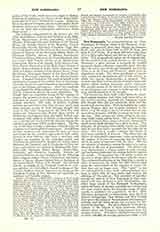

New Pomerania, Vicariate Apostolic of.—New Pomerania, the largest island of the Bismarck Archipelago, is separated from New Guinea by Dampier Strait, and extends from 148° to 152° E. long. and from 4° to 7° S. lat. It is about 348 miles long, from 12% to 924 miles broad, and has an area of 9650 sq. miles. Two geographical regions are distinguishable. Of the northeastern section (known as the Gazelle Peninsula) a great portion is occupied by wooded mountain chains; otherwise (especially about Blanche Bay) the soil is very fertile and admirably watered by rivers (e.g. the Toriu and Kerawat), which yield an abundance of fish. The white population is practically confined to the northern part of this section, in which the capital, Herbertshohe, is situated. The western and larger section also has extensive mountain chains, which contain numerous active volcanoes. The warlike nature of the natives, who fiercely resent as an intrusion every attempt to land, has left us almost entirely ignorant of the interior.
The natives are finely built, coffee brown in color, have regular features, and, when well cared for as at the mission stations, approach the European standard, though their lips are somewhat thick and the mouth half or wide open. While resembling the southeastern Papuan, they use weapons unknown to the latter—e.g. the sling, in the use of which they possess marvelous dexterity, skillfully inserting the stone with the toes. They occupy few towns owing to the constant feuds raging among them. One of their strangest institutions is their money (dewarra), composed of small cowrie shells threaded on a piece of cane. The difficulty of procuring these shells, which are found only in very deep water, accounts for the value set on them. The unit is usually a fathom (the length of both arms extended) of dewarra. The tribes have no chiefs; an individual’s importance varies according to the amount of dewarra he possesses, but the final decision for peace or war rests with the tribe. This entire absence of authority among the natives is a great obstacle in the way of government. The natives are very superstitious: a demon resides in each volcano, and marks his displeasure by sending forth fire against the people. To propitiate the evil spirits, a piece of dewarra is always placed in the grave with the corpse. The celebrated institution of the Duk-Duk is simply a piece of imposture, by which the older natives play upon the superstitions of the younger to secure the food they can no longer earn. This “spirit” (a native adorned with a huge mask) arrives regularly in a boat at night with the new moon, and receives the offerings of the natives. The standard of morality among the natives of New Pomerania is high compared with that observed in New Mecklenburg (the other large island of the Bismarck Archipelago), where the laxity of morals, especially race suicide and the scant respect shown for marriage, seems destined rapidly to annihilate the population. In November, 1884, Germany proclaimed its protectorate over the New Britain Archipelago; New Britain and New Ireland were given the names of Neupommern and Neumecklenburg, and the whole group was renamed the Bismarck Archipelago. The great obstacle to the development of the islands is their poisonous climate, neither native nor European being immune from the ravages of fever. The native population is estimated at about 190,000; the foreign population (1909) at 773 (474 white). About 13,464 acres are under cultivation, the principal products being copra, cotton, coffee, and rubber.
The vicariate Apostolic was erected on January 1, 1889, and entrusted to the Missionaries of the Sacred Heart of Issoudun. Since September, 1905, when the Marshall Islands were made a separate vicariate, its territory is confined to the Bismarck Archipelago. The first and present vicar Apostolic is Msgr. Louis Couppe, titular Bishop of Leros. The mission has already made remarkable progress, and numbers according to the latest statistics 15,223 Catholics; 28 missionaries; 40 brothers; 27 Sisters of Our Lady of the Sacred Heart; 55 native catechists; 77 churches and chapels; 90 stations (26 chief); 29 schools with over 4000 pupils; 13 orphanages.
THOMAS KENNEDY

